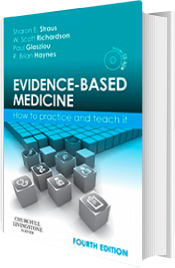You are asked to see a 73 year old patient on ITU who is being treated for a head injury after a road traffic accident. She has osteoarthritis and was taking a regular dose of a non-steroidal anti-inflammatory prior to hospitalization. She has had a small haematemesis and, on oesophago-gastro duodenoscopy you diagnose NSAID erosions. She has a negative CLO test for helicobacter pylori. You suggest treatment with ranitidine. Your ITU colleague recommends sucralfate as an alternative and sites evidence of lower rates of infection with sucralfate. You appraise the literature together.
You formulate the question “In patients on ITU is rantidine or sucralfate associated with a lower rate of infections?” You track down the Annals of Surgery article that she has referred to.Annals of Surgery 1998;227:120-125.
Read the article and decide:
- Are the results of this harm study valid?
- Are the results of this harm study important?
- Should these valid, important results of this study about a potentially harmful treatment change the treatment of your patient?
Completed Harm Worksheet for Evidence-Based Gastroenterology and Hepatology
Citation
O’Keefe GE, Gentilello LM, and Maier RV. Incidence of infectious complications associated with the use of Histamine-2-receptor antagonists in critically ill trauma patients.Annals of Surgery 1998;227:120-125.
Are the results of this harm study valid?
- Were there clearly defined groups of patients, similar in all important ways other than exposure to the treatment or other cause?
- Subjects were participants in an RCT. Randomization should distribute all other exposures equally. The only significant difference between groups was duration of ITU stay (longer for ranitidine patients). After controlling for other factors only treatment with ranitidine was associated with longer stay.
- Were treatment exposures and clinical outcomes measured the same ways in both groups (e.g., was the assessment of outcomes either objective (e.g., death) or blinded to exposure)?
- Yes
Do the results satisfy some “diagnostic tests for causation”?
- Is it clear that the exposure preceded the onset of the outcome?
- Not clear. Treatment was commenced on admission to ITU but some patients may have entered ITU with infections. However randomisation should distribute these cases equally in both groups.
- Is there a dose-response gradient?
- No
- Is there positive evidence from a “dechallenge-rechallenge” study?
- No
- Is the association consistent from study to study?
- Not known
- Does the association make biological sense?
- Probably, given the widespread effects of H2 antagonists
Are the valid results from this harm study important?
| Adverse Outcome | Totals | |||
|---|---|---|---|---|
| Present (Case) | Absent (Control) | |||
| Exposed to the Treatment | Ranitidine (Cohort) | 75.5% a |
b | a + b |
| Sucralfate (Cohort) | 55.3% c |
d | c + d | |
| a + c | b + d | |||
In this study:
$$qquad mathit{Relative Risk (RR)} = 75.5%/55.3%\
qquad mathit{Relative Risk (RR)} = 1.36 \
qquad p = 0.04
$$
NB this differs from the RR presented in the text!!
Should these valid, potentially important results of a critical appraisal about a harmful treatment change the treatment of your patient?
- Can the study results be extrapolated to your patient?
- Yes
What are your patient’s risks of the adverse outcome?
To calculate the NNH (the Number of patients you Need to treat to Harm one of them) for any Odds Ratio (OR) and your Patient’s Expected Event Rate for this adverse event if they were NOT exposed to this treatment (PEER):
$$
qquad mathit{NNH} = frac{mathit{PEER}(mathit{OR}-1)+1}{mathit{PEER}(mathit{OR}-1)times(1-mathit{PEER})}$$
If we assume our patient is like the average individual in this, then her Absolute Risk Increase in infectious complications whilst in hospital is
$$
qquad 75.5% – 55.3% \
qquad = 20.2% \
qquad text{and 1/.202 gives an $NNH$ of 5.}
$$
- What are your patient’s preferences, concerns and expectations from this treatment?
- Need to be determined.
- What alternative treatments are available?
- Sucralfate is clearly one alternative. Proton pump inhibitors have not been investigated in this study.
Additional Notes
The evidence favours the use of sucralfate rather than ranitidine in this situation leading us to chose to use a drug that we would not normally prescribe for NSAID induced gastric erosions.
Critically ill trauma patients – Sucralfate is associated with lower infection rate than ranitidine
Clinical Bottom Line
- Sucralfate is associated with a lower incidence of infectious complications than ranitidine in critically ill trauma patients.
- The number of patients needed to be treated with sucralfate rather than ranitidine to avoid one infectious complication is 5.
Citation
Keefe GE, Gentilello LM, and Maier RV. Incidence of infectious complications associated with the use of Histamine-2-receptor antagonists in critically ill trauma patients.Annals of Surgery 1998;227:120-125.
Clinical Question
In critically ill trauma patients with gastric erosions is sucralfate or ranitidine associated with fewer infectious complications?
Search Terms
From our ITU colleagues desk top reprint or from MEDLINE using “sucralfate” and “infection”
The Study
Data were extracted from a randomised controlled trial to compare sucralfate with ranitidine in the control of stress gastritis in critically ill trauma patients. The data concerning pneumonia incidence were collected prospectively, other infectious complications were obtained from the records retrospectively.
The Evidence
| Infectious complications | Totals | ||
|---|---|---|---|
| Present | Absent | ||
| Treated with ranitidine | 75.5% a |
b | a + b |
| Treated with sucralfate | 55.3% c |
d | c + d |
| a + c | b + d | ||
$$qquadtext{Relative Risk ($RR$)} = 75.5%/55.3% \
qquadtext{Relative Risk ($RR$)} = 1.36 \
qquad p = 0.04
$$
Comments
- Sucralfate is associated with fewer infectious complications than ranitidine in the treatment of critically ill patients with gastric erosions.
- The mechanism leading to this finding is unknown but it is suggested that it may be due to the more general effects on the immune system of H2 antagonism.

